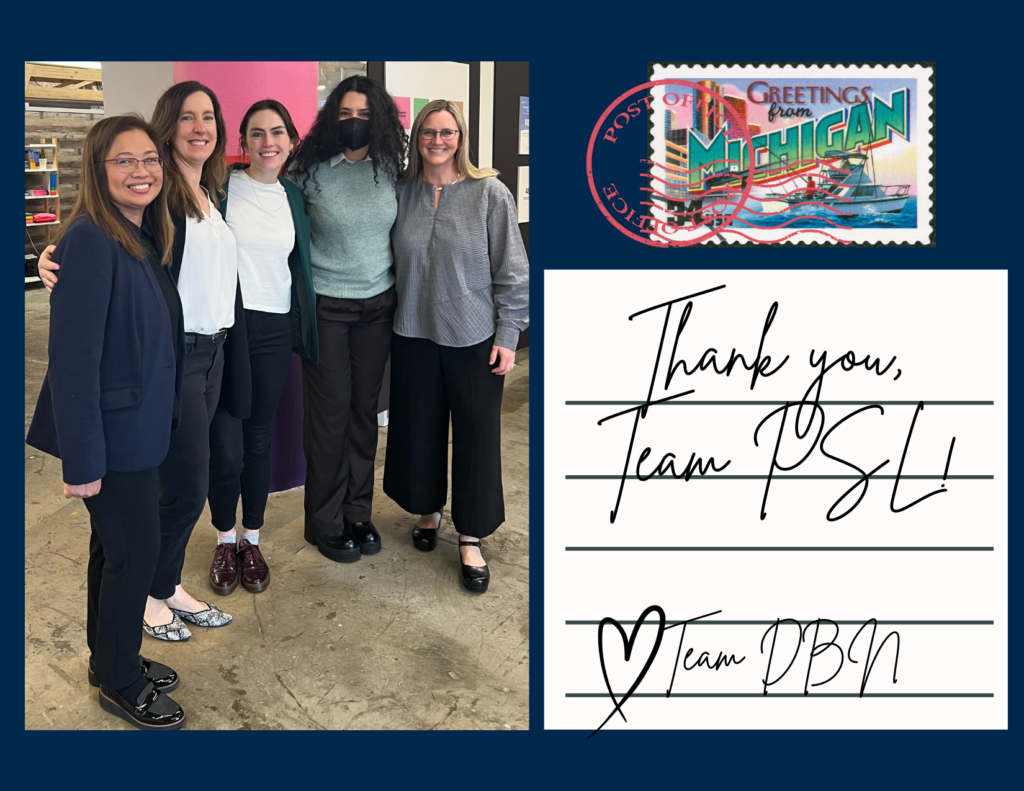Postcards from the Community: Digital Benefits Network Team Visits Michigan
DBN is starting 2024 with momentum and added two new staff to the team in January. This team hit the ground running and headed to Michigan to visit network partners on March 12-13, 2024.
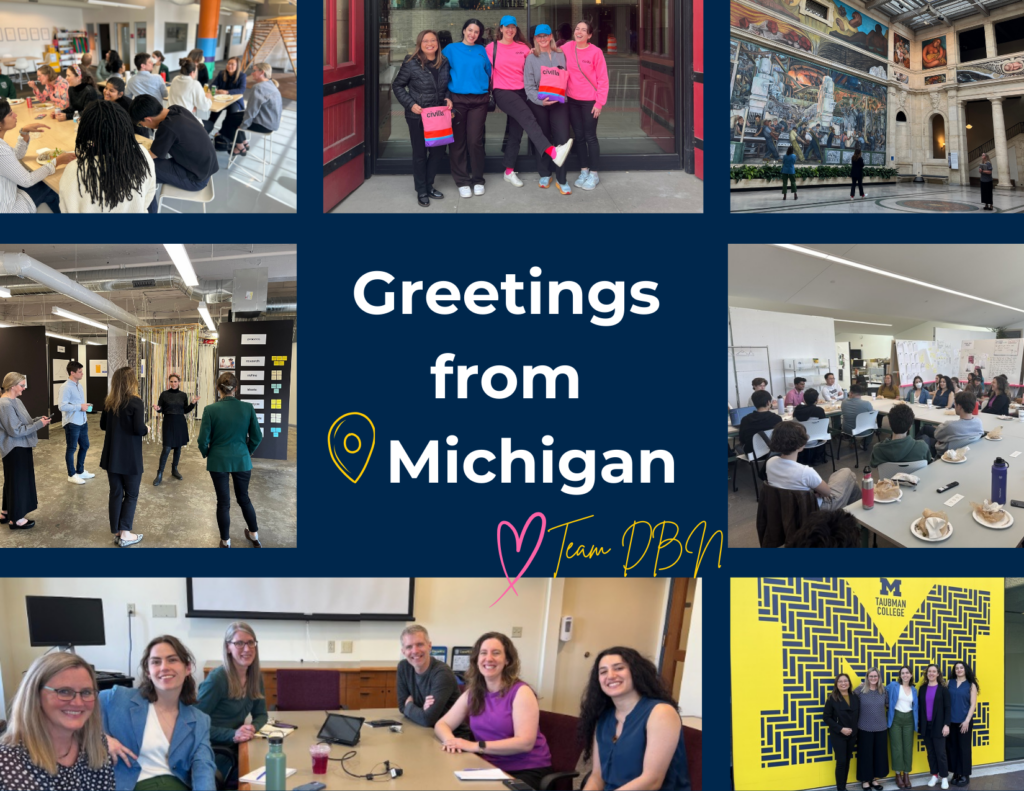
Since 2022, the Digital Benefits Network has been steadily growing the community of practitioners working to expand equitable access to public benefits through the implementation of innovative and proven approaches. In 2023, we hosted the inaugural BenCon and the ever-growing Digital Benefits Hub was used by over 13,000 practitioners. DBN is starting 2024 with momentum and added two new staff to the team in January. This team hit the ground running and headed to Michigan to visit network partners on March 12-13, 2024.
Team DBN includes Ariel Kennan (Senior Director), Jennifer Phillips (Program Lead Network Collaboration), Elizabeth Bynum Sorrell (Project Researcher), Maya Salemeh (Program + Data Manager), and Tina Amper (Community Advisor, Rules As Code Community of Practice).
Let us take you on a virtual tour and share what we learned!
Civilla: Detroit, MI
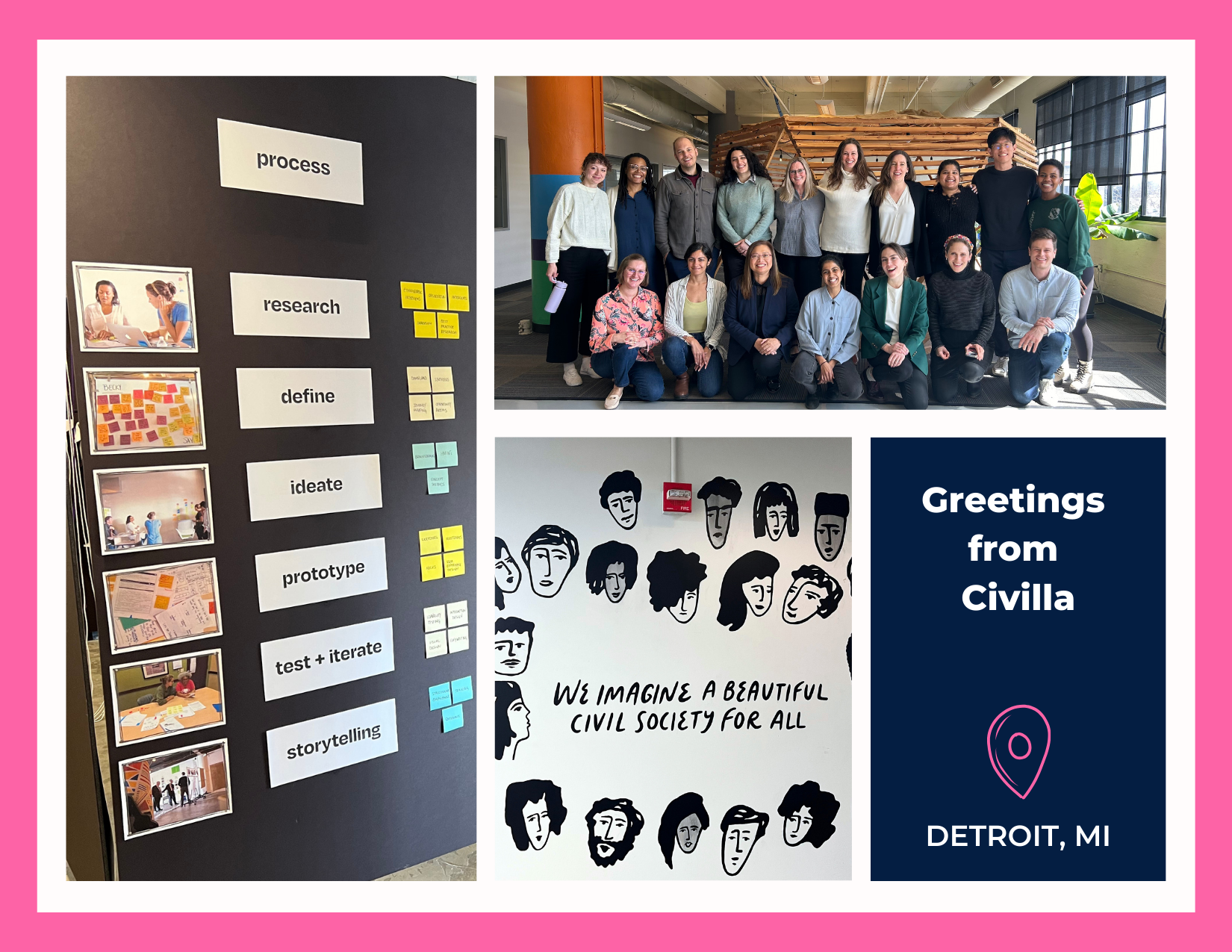
Greetings from Civilla, a non-profit design studio changing the way public-serving institutions work through human-centered design (HCD). Team DBN got to meet and have lunch with Team Civilla, walk through their design studio space, and sit down for a conversation about the future of human-centered digital benefits delivery.
Civilla’s Re:form story started in 2015 with the Michigan Department of Health and Human Services’ (MDHHS) benefits application form DHS-1171. Containing over 1000 questions and 42 pages long, Civilla created a 100-foot long scroll of this application, a battle-worn artifact they showed us during our tour.
They also created a journey map of every step in the benefits application and enrollment process — it stretches the length of the room!
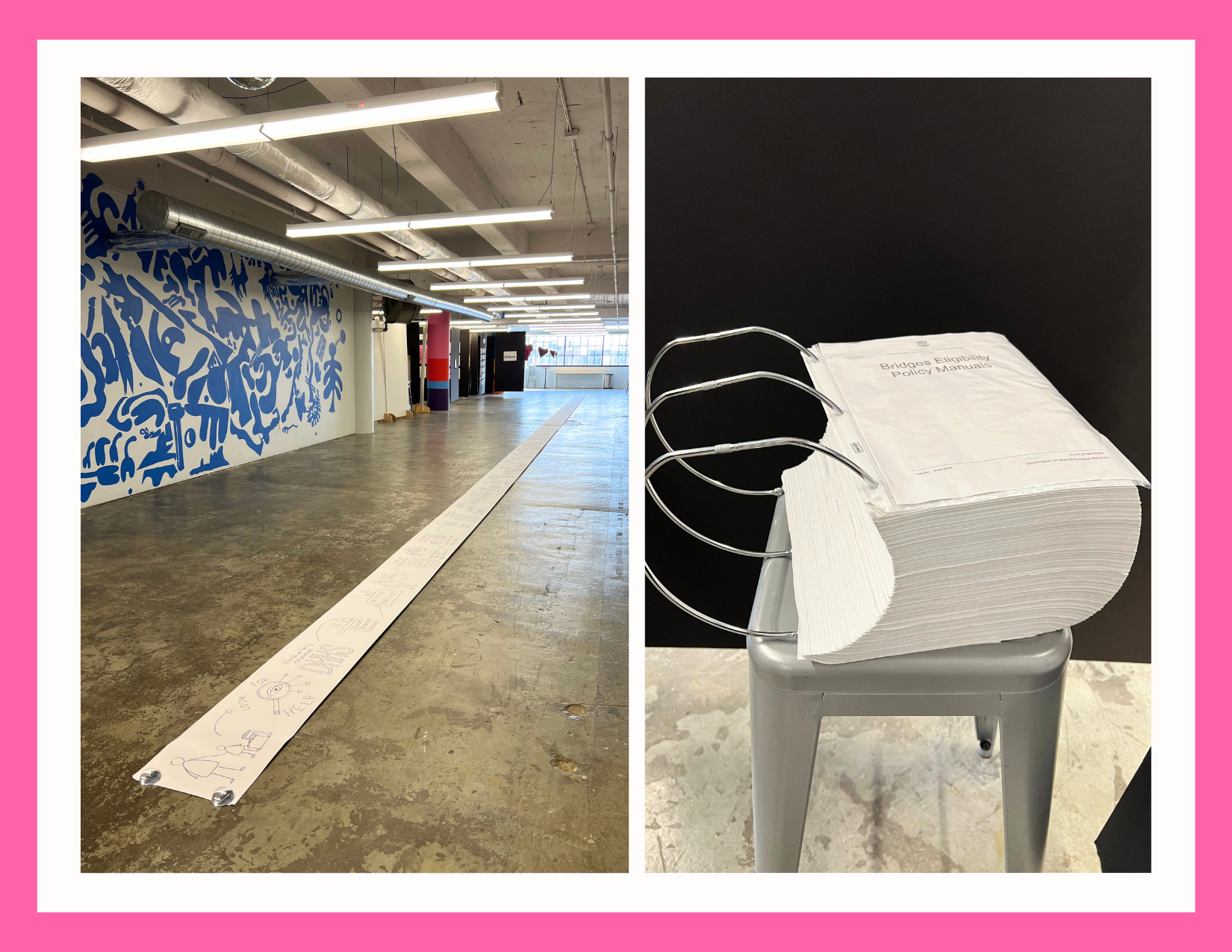
The prior MDHHS benefits application was not unlike those in many states and counties that administer various public benefits programs. Some benefit applications still exist on paper and others have been digitized without any simplifications, options for languages other than English, and not in mobile-friendly formats. They are basically the 42-page application, only now online. These complex applications create barriers for people from accessing benefits across the country and across public benefit programs.
Working with Civilla, MDHSS unveiled a new application format in 2023 that is 80% shorter and nearly 50% faster to process. Civilla has also worked with the Missouri Department of Social Services on their enrollment process for six safety net programs and is now working with Michigan’s Unemployment Insurance Agency (UIA).

Back in December 2021, the White House issued an executive order titled Executive Order on Transforming Federal Customer Experience and Service Delivery to Rebuild Trust in Government. In March 2024, the Biden Administration’s budget asked for $500 million to modernize services, reduce administrative burdens and pilot online tools, with a focus on using customer voices to drive improvements. This work is already taking root at USDOL’s Employment and Training Administration (both UI and WIOA) and USDA’s Food and Nutrition Services as these federal agencies are guiding states to utilize HCD approaches to improve digital public benefit delivery.
Civilla and Team DBN’s discussion zeroed in on some key themes and future-forward questions related to helping state agencies embrace HCD:
- Leadership and frontline staff buy-in and engagement are critical to undertaking HCD approaches (as is the structuring of the change management process).
- States have to embrace being vulnerable when deconstructing applications and enrollment processes.
- Developing proof points along the way is essential; seeing is believing.
- What needs to happen infrastructure-wise to support HCD and capacity building in states?
- How can we start measuring impact on the benefits of HCD as a continuous improvement strategy?
- What are ways to model and elevate effective ways for governments and nonprofits to collaborate?
Want to learn more?
Explore HCD resources on the Digital Benefits Hub.
- The Beeck Center and Civilla have also co-created two HCD guides:
- Check out Civilla’s online Practica courses or contact them about HCD learning for teams.
Thank you to Civilla for being such generous hosts and providing Team DBN such a powerful sensory experience walking through a redesigned application process in your studio!
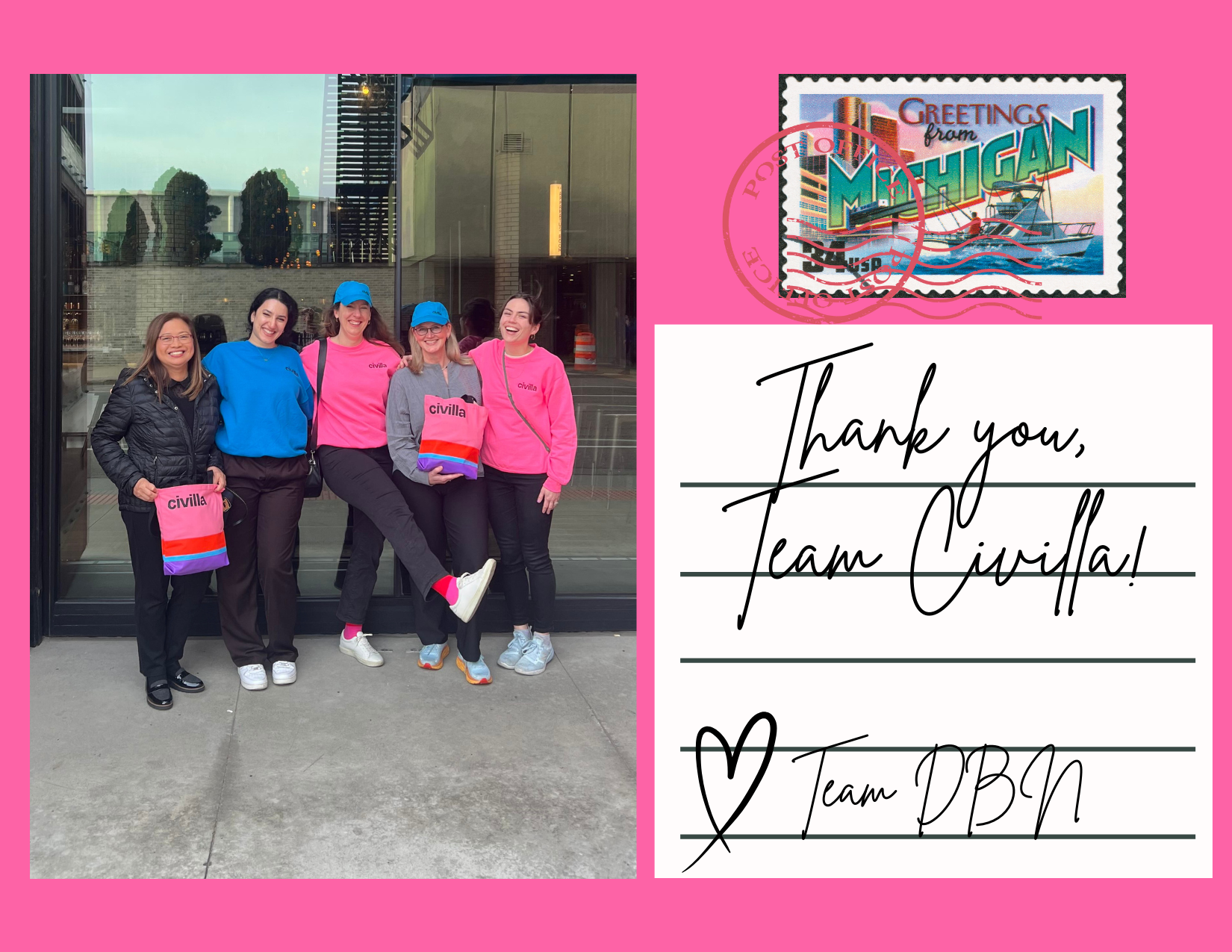
Conversation with Brett Gleason, Chief of Staff, Michigan Unemployment Insurance Agency (UIA)
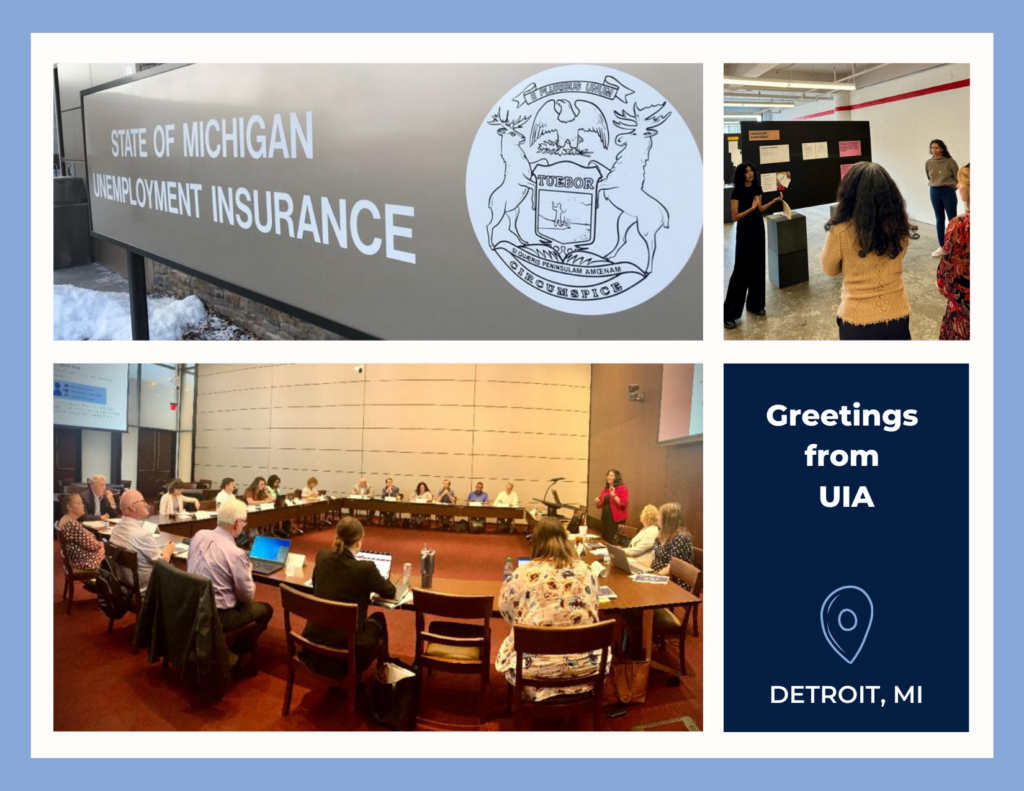
While at Civilla, Team DBN had the opportunity to meet up with UIA’s Chief of Staff, Brett Gleason, to learn firsthand how UIA has worked with Civilla to transform claimant and employer experiences with unemployment insurance (UI).
Michigan UIA followed MDHHS’s lead and procured Civilla services to use HCD approaches to improve both claimant and employer experiences. They leveraged American Rescue Plan Act (ARPA) funds for modernizing unemployment insurance systems and generated new Claimant Roadmap and Employer Help Center, making navigating and interacting with UIA more customer-friendly. The DBN highlighted Michigan UIA work with Civilla in our December 2023 report, Promising Practices in State Unemployment Insurance Digital Service Delivery.
The pandemic exposed cracks in all state UI agencies’ foundations. Much attention was placed on their capacity, or lack thereof, to detect and prevent fraud but there was also an important focus on claimant access and experience. USDOL’s Office of UI Modernization, through its ARPA funded-initiatives and through policy guidance that includes journey mapping, have been encouraging states to take a customer experience approach that has the potential to improve system integrity, timeliness, and equitable access to UI. UIA is now also working with Deloitte on implementing/rolling out a new UI digital system.
Brett shared his thoughts about UIA’s ingredients for success and ways a customer-centric approach can be part of a government agency’s continuous improvement strategy.
Ten Thoughts About Ingredients for Success
- Increasing empathy through HCD. Brett shared that incorporating HCD into agency dialogue makes the service delivery process more empathetic, especially for economic first-responder agencies like UIA.
- Make change management an agency-wide effort. Brett said with the right investments and the right partners, this is all possible. UIA Director Dale is building a “coalition of the willing” by evangelizing the art of the possible and creating a cadre of change champions across all levels of the agency.
- Strategically deploy change champions. UIA has hired a small team of project managers and an HCD specialist who can accompany projects and advocate for claimants while making conversations less one-sided from an agency-only perspective.
- Don’t limit change management to inside the agency. UIA has launched a UI modernization work group investing in community relationships seeking community input. Brett referred to this as the agency being in a “season of rebuilding trust.”
- Try not to make decisions at the expense of customers — both claimants and employers. For example, working to let go of long-time, insider UI terminology, such as “re-determination,” on a notice and changing it to something easier to understand, such as “claim update.”
- Make all the steps in the claims process easier to understand and follow. UIA is hosting weekly live, virtual claim filing help sessions, which were born out of an HCD-identified need for ‘accompaniment’ during the process.
- Know when to accelerate automated processes and when to lean into parts of the process where human touch is still essential. UIA used its ARPA Equity Grant to create Community Connect, a cohort of ten community liaisons assisting workers in underserved communities throughout Michigan. Through these groups they have learned about various community needs, such as providing the employer portal in Spanish.
- Use strategic investment to show what’s possible. Brett shared that the ARPA grants have been paramount to standing up new work while also tackling the claim backlog and climbing out of the pandemic’s crisis mode. He encouraged elevating use cases and examples wherever possible to help grow buy-in and accelerate change.
- Use data to understand claimant experience and make decisions. Follow the behavioral insights research; examine the analytics and testing. Find and apply the process improvements that result from using an HCD lens.
- Don’t forget how passionate people in state governments are! UIA is working to build excitement, morale and joint ownership from within. Director Dale sent an all-staff email with these UIA Design Directives and Principles co-created with Civilla with an uplifting call that everyone can use these tenets to improve service to Michigan’s workers and employers.

Thanks Brett for spending time giving us a glimpse into UIA’s future-forward UI modernization work! Team DBN is excited to continue to host spaces for state public benefits leaders to share and discuss how to transform digital benefits delivery.
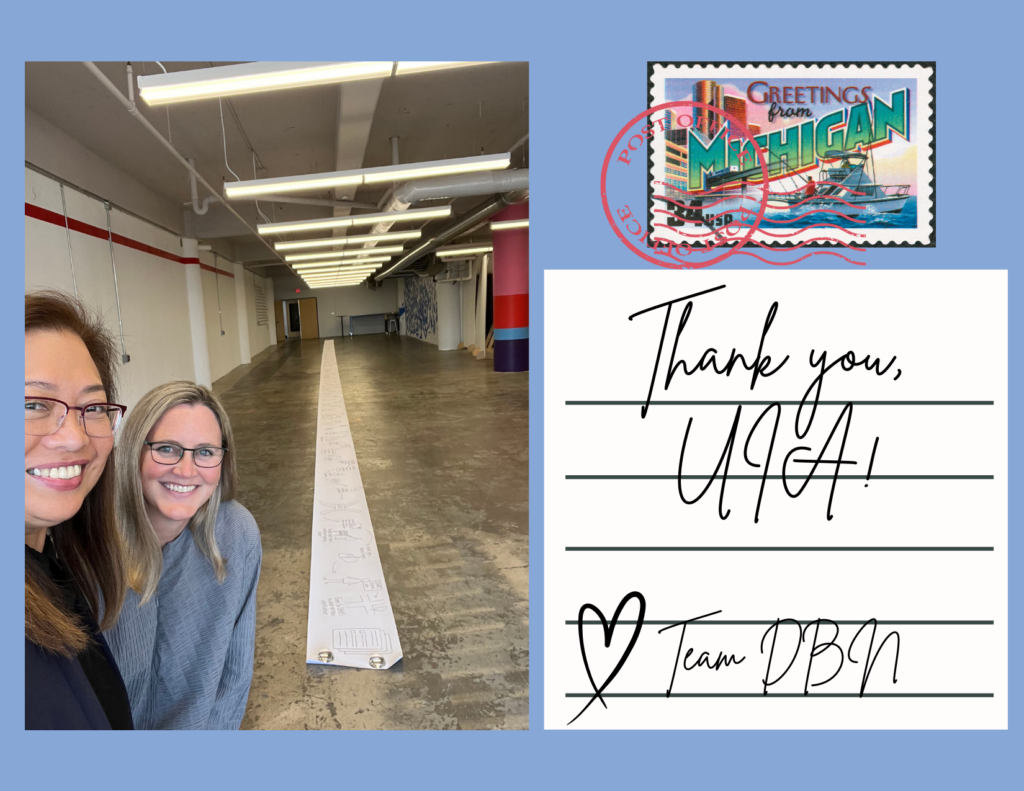
Taubman School of Architecture, University of Michigan Ann Arbor, Urban Technology Student Lunch
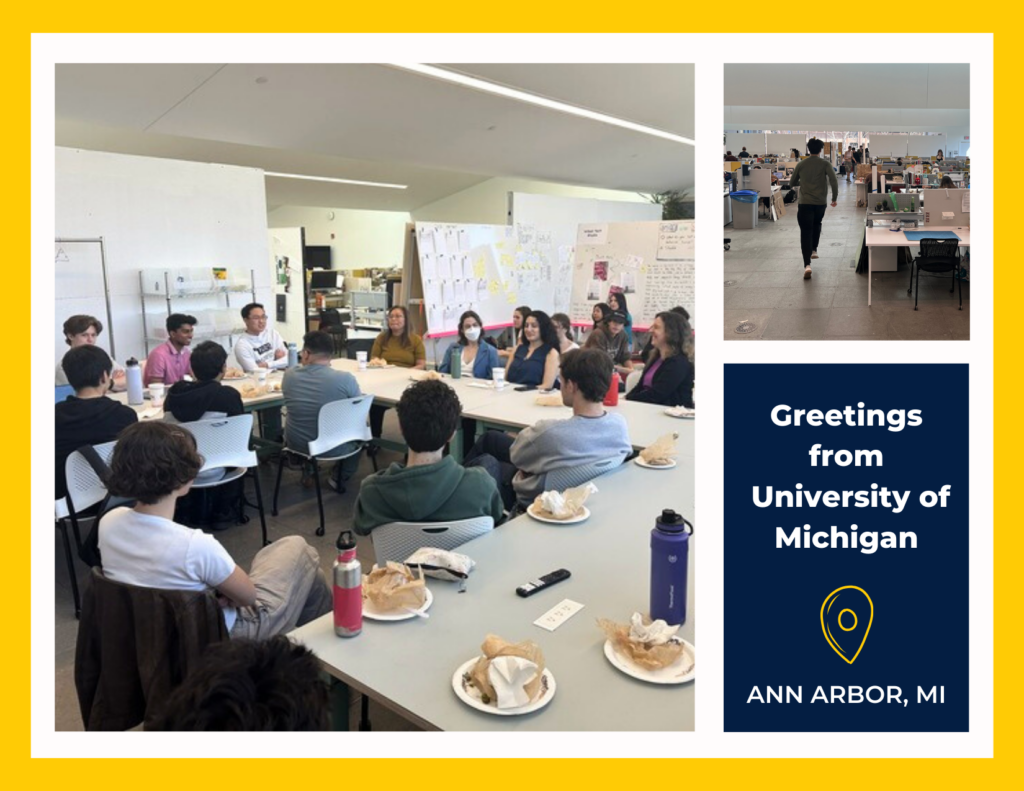
Greetings from Ann Arbor, where Team DBN had the pleasure of being lunch guests and speakers of the Taubman School of Architecture’s Urban Technology students organization.
The new Bachelor of Science in Urban Technology degree at Taubman College of Architecture and Urban Planning is the brainchild of Bryan Boyer, its founding director, long-time leader in civic design, and current board member at Public Policy Lab, a New York-based nonprofit focused on human-centered system design.
Team DBN got a chance to share the origins of DBN and its current work and how we see design, data, delivery and technology working together to improve how people interact with public benefit systems. Students asked us about how governments at all levels are thinking about civic tech and what these jobs may look like. Spoiler alert: most of the jobs we talked about haven’t even been created yet (but we think/hope they will be soon!). Conversation was rich in how public problem-solving and solution-creating require approaches that blend design-thinking, humanity-centered thinking, advocacy, community engagement, public policy analysis, data science, and technology to be successful now and in the future.
Urban Tech students are also learning from the best in civic tech as they have Ron Bronson, Director of Design at 18F, teaching Service Design and Urban Needs this semester.

Bryan also showed us around the New Lab at Michigan Central — a space for incubating the future of mobility. We’re excited to see the full Michigan Central building open this summer as a milestone in Detroit’s urban renewal!
Thank you Bryan Boyer and Urban Tech students for a great conversation and a shout out in your substack!
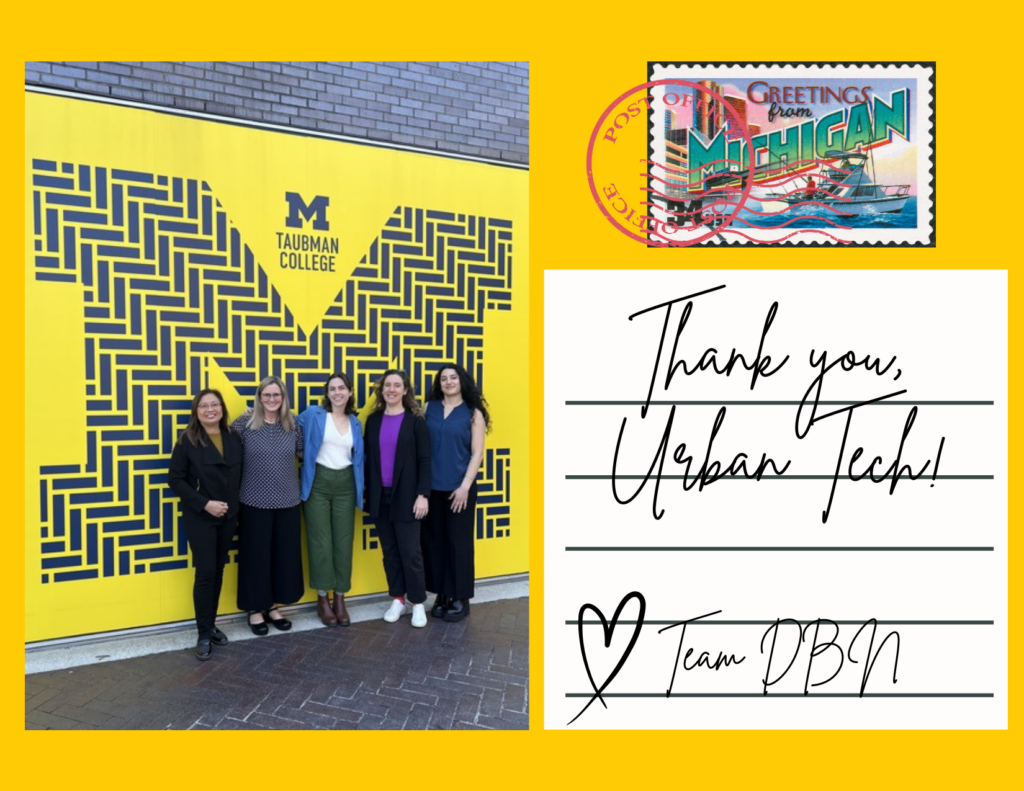
Poverty Solutions Lab, University of Michigan Ann Arbor Gerald R. Ford School of Public Policy
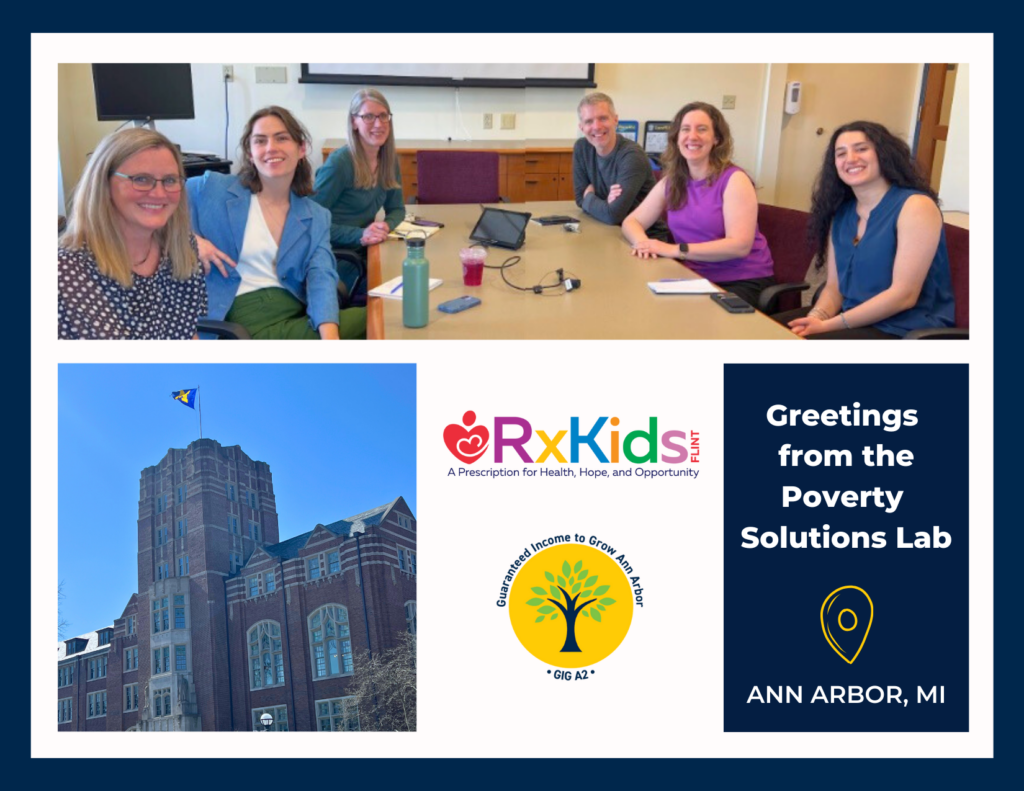
Greetings from the Poverty Solutions Lab, an action-based policy research center at the University of Michigan in Ann Arbor!
Team DBN has been cheering for Flint, Michigan as it launched its seminal, no-strings-attached cash transfer initiative, RxKids in January. The March Benefits Digest featured several related articles, including an in-depth piece by PBS News Hour and a 7-minute listen on NPR about cash transfer initiatives being tested across the country. Michigan is also home to another new cash transfer experiment, Guaranteed Income to Grow Ann Arbor, or GIG-A2.
Team DBN was lucky to catch up with Poverty Solutions Lab director, Dr. Luke Shaefer, who is co-directing RxKids, and Associate Director, Dr. Kristin Seefeldt, who is spearheading GIG-A2.
Spotlight on RxKids
Dr. Luke Shaefer works with Dr. Mona Hanna-Attisha as the co-directors of RxKids. Luke was a special counselor to Michigan’s Department of Health and Human Services from 2019-2021. Dr. Hanna-Attisha is a pediatrician and Associate Dean for public health at the Michigan State College of Human Medicine. She played an instrumental role uncovering the Flint water crisis and the severe consequences for children and helped inspire the effort to create RxKids.
RxKids is a ‘prescription’ for economic well-being, with cash transfers totalling $7,500given throughout a woman’s pregnancy and the first year of her child’s life. RxKids application process is run on AidKit, known for its easy-to-use application technology. This first-of-its-kind program was seeded with a $15 million grant from the C.S. Mott Foundation and has raised over $43 million of its $55 million goal. Another groundbreaking aspect of RxKids is its use of TANF funds.
Last March, the U.S. Department of Human Services (HHS), Administration for Children and Families (ACF) issued policy guidance to all states on Non-Recurrent Short-Term Benefits (NRSTs), allowing states to use TANF funds to provide similar cash or in-kind services to families with children without triggering behavioral requirements and time limits.
Under this policy guidance, Governor Whitmer’s administration has proposed using $24 million for this type of prenatal and infant support programming and would like to see RxKids expand to other Michigan cities. Luke shared that research and implementation teams at University of Michigan and Michigan State University are hoping to see HHS-ACF provide additional clarification on the use of NRSTs.
The RxKids research will use administrative data to look for the “difference in the differences,” analyzing a broad range of data including vital, Medicaid, maternal well-being, and housing records.
Spotlight on GIG-A2
Guaranteed Income to Grow Ann Arbor (GIG A2) (2 minute video) is a 2-year program that will provide monthly payments of $528 to 100 entrepreneurs with low or very low income. GIG A2 was authorized by the Ann Arbor City Council in June 2023 using $1.6 million in ARPA funds.
Poverty Solutions Lab is implementing and studying this initiative. The research is multi-method, including random assignment. The study is also set up to give $25 monthly cash cards to those in the control group.
Kristin shared the struggles DBN often hears from state and federal agencies about income verification and that GIG-A2 is working to be more broadly inclusive of what counts as verification, especially for entrepreneurs and gig workers. Integrity as well as benefit cliff issues have also taken some time to work through.
The Future of Accessible, Equitable, and Ethical Digital Service Delivery
Aside from learning about both cash transfer initiatives, Luke, Kristin and Team DBN talked about the future of accessible, equitable, and ethical digital service delivery. Below are a few conversation highlights:
- How can digital benefit access allies begin to talk about program integrity in a positive light? In what ways can we collectively reframe the narrative to, “if you care about equitable access, you have to also care about program integrity?” And how might easier, more streamlined access actually improve benefit system integrity?
- We discussed all the measures the RxKids team has worked through to ensure that parents don’t face devastating benefit cliffs that occur when increases to income cause benefits to be reduced at a larger rate. RxKids specifically worked to safeguard that from happening for SNAP and Medicaid.
- Kristin also reminded us about the challenges of program implementation. She shared a story about how challenging it is for people experiencing benefit cut-offs for no apparent reason, and that benefit systems have a long way to go to build trust with the communities who need them due to the lack of transparency in benefits delivery.
Thank you Kristin and Luke for your insights on both initiatives and such a rich conversation about how organizations like DBN and Poverty Solutions Lab might collaborate to elevate new ways we might frame digital benefit delivery issues.
